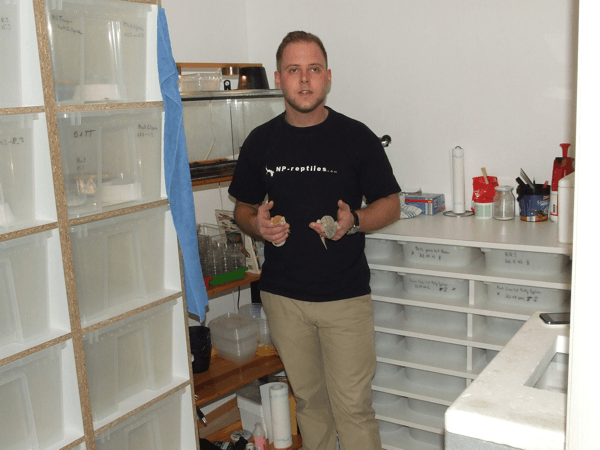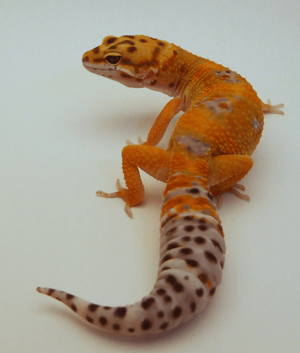This week, Gecko Time has had the opportunity to speak with Nico Pietrzyk, a young leopard gecko breeder from Germany. He was good enough to share some information about his leopard gecko activities and the gecko scene in Germany as well.
Tell us a little about yourself and how you got interested in geckos.
I am 26 years old and come from Germany. I have been interested in unusual animals as long as I can remember. As a young boy I had all kinds of pets. I think I got my first real exotic animal at age 9. That was a turtle. Unfortunately I had to get rid of him, because it became too big and I had no space for a large aquarium. At the age of 12 years (1998) a friend of my mother told her about her leopard geckos. Two days later I went on a school trip and when I came back, I had my first leopard gecko. Meanwhile, I have also kept ball pythons, tarantulas and scorpions. The leopard geckos are the
ones I never lost interest in.
How many leopard geckos do you have and how many do you produce each year?
My motto is: quality, not quantity!
I have only a very very small collection, when I compare myself with other breeders. My breeding stock is limited to about 20 animals, some fraction of which I breed each year. That way I can have my full-time job and the family and there is still enough time to care for each animal in particular as well as the other important things involved with this hobby such as contacting other breeders and training in genetics too. We have only a very small number of offspring per year. I can’t give specific numbers because it varies from year to year.
The number depends on the projects but there are never more than 30. The reason for this low number is, as mentioned above, that I want to take care of every single gecko especially. Another reason for the low number is that I don’t have to earn money breeding geckos. For me it is a hobby. I am paying for it gladly!
How do you keep your geckos –what kind of cages and set-up?
I keep my leopard geckos mainly in racks. I keep our breeders individually in 45 litre tubs. The offspring will accordingly be housed in smaller tubs, until they reach a certain size. Then they are transferred to a bigger tub . Most breeders in Germany keep their animals in cages. I opted for racks for hygiene reasons and because of the better control I have with racks. By keeping the geckos individually I have better control and can determine which eggs go with which females 100%. But the basic hygiene may not be ignored. I do not have much stuff in the tubs besides the basics: a humid hide filled with coco fiber on the warm side, another regular cave on the cold side, a calcium dish and a water bowl.
What morphs do you work with?
I work with morphs like Eclipse, Tangerine and Rainwater Albino. But the Rainwater’s have stolen my heart. I was lucky enough to get from a friend a couple of Raining Red Stripes from the Hotgeckos line. With these Raining Red Stripes I continue to do selective line breeding. This year I bred my Raining Red Stripe male to a beautiful Electric Tangerine female. I hope this will improve the color of our Rainwater’s again in the next generation. But these are not the only Las Vegas Albinos in my stock. The Mack Snow and the Patternless gene play a role as well. I expect some great offspring this year, including: Mack Snow Rainwater, Mack Snow Rainwater Patternless, Mack Super Snow Rainwater and Mack Super Snow Rainwater Patternless.
Tell us about the breeding project that has interested you the most.
Also here again clearly the Rainwater Albinos call. Why? Tremper Albinos and Bell Albinos are a dime a dozen. But there are not so many Rainwater Albinos. This focus on the “unknown”, is what makes me so interested in that. The Rainwater Albinos there have been in existence for 15 years, but they have never had anyone really interested. Since last year, I can see a growing interest in the Las Vegas strain and the Typhoons, which makes me very happy. I hope this still be able to inspire more good breeders for these wonderful animals. Here are a lot of unopened doors.
What is the leopard gecko breeder community like in Germany?
Here in Germany we have a large gecko community, with many hobby breeders. Most communication takes place in our discussion forums. Photos will be posted here, projects presented and information exchanged. Once a year, a lot of us more or less agree to meet for a coffee in Hamm at the reptile show. Not only in the U.S. are there beautiful geckos. 😀
In Germany there are some great breeders with interesting breeding projects.
Some of our well established and experienced breeders I know include Karsten Griesshammer with his W&Y, Rebecca Hassler of Dragoongecko with her Ghost and Electric line breeding, Dennis Leder with his Snow Diorite-stuff from Japan and Christoph Mainka of Geckosphere. Christoph has hatched, to my knowledge, the first Super Snow Patternless Bell which is still alive in the world. Of course there are other promising and talented people around, and new breeders coming into the hobby every year.
What would be your advice to someone who would like to begin breeding leopard geckos?
I would recommend to start very, very small, and possibly not breeding at all in the early years. First you have to do your homework. Learn, learn and learn as much as you can. If you then have enough experience, you can think about whether you might breed 1-2 females. If all goes well, you can gradually increase. Patience in this hobby is a very important virtue.



